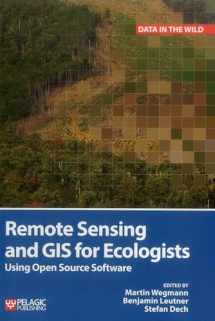
Remote Sensing and GIS for Ecologists: Using Open Source Software (Data in the Wild)
ISBN-13:
9781784270230
ISBN-10:
1784270237
Author:
Martin Wegmann, Benjamin Leutner, Stefan Dech
Publication date:
2016
Publisher:
Pelagic Publishing
Format:
Hardcover
324 pages
Category:
Data Mining
,
Databases & Big Data
FREE US shipping
Book details
ISBN-13:
9781784270230
ISBN-10:
1784270237
Author:
Martin Wegmann, Benjamin Leutner, Stefan Dech
Publication date:
2016
Publisher:
Pelagic Publishing
Format:
Hardcover
324 pages
Category:
Data Mining
,
Databases & Big Data
Summary
Remote Sensing and GIS for Ecologists: Using Open Source Software (Data in the Wild) (ISBN-13: 9781784270230 and ISBN-10: 1784270237), written by authors
Martin Wegmann, Benjamin Leutner, Stefan Dech, was published by Pelagic Publishing in 2016.
With an overall rating of 4.5 stars, it's a notable title among other
Data Mining
(Databases & Big Data) books. You can easily purchase or rent Remote Sensing and GIS for Ecologists: Using Open Source Software (Data in the Wild) (Hardcover) from BooksRun,
along with many other new and used
Data Mining
books
and textbooks.
And, if you're looking to sell your copy, our current buyback offer is $0.3.
Description
This is a book about how ecologists can integrate remote sensing and GIS in their daily work. It will allow ecologists to get started with the application of remote sensing and to understand its potential and limitations. Using practical examples, the book covers all necessary steps from planning field campaigns to deriving ecologically relevant information through remote sensing and modelling of species distributions.All practical examples in this book rely on OpenSource software and freely available data sets. Quantum GIS (QGIS) is introduced for basic GIS data handling, and in-depth spatial analytics and statistics are conducted with the software packages R and GRASS.Readers will learn how to apply remote sensing within ecological research projects, how to approach spatial data sampling and how to interpret remote sensing derived products. The authors discuss a wide range of statistical analyses with regard to satellite data as well as specialised topics such as time-series analysis. Extended scripts on how to create professional looking maps and graphics are also provided.This book is a valuable resource for students and scientists in the fields of conservation and ecology interested in learning how to get started in applying remote sensing in ecological research and conservation planning.


We would LOVE it if you could help us and other readers by reviewing the book
Book review

Congratulations! We have received your book review.
{user}
{createdAt}
by {truncated_author}


